Clownfish is quite peaceful and non-aggressive. These fishes are available in a variety of species. This guide is especially for those planning to buy a clownfish but is confused about which one to choose.
If you are a beginner and don’t have much interest in keeping fish, you would also be excited to have at least one clownfish after reading this guide. This guide will discuss 15 different types of clownfish for your aquarium. But first, let us discuss some important facts you should know about a clownfish.
Table of Contents
About Clownfish
Most Clownfish prefer to live in saltwater. They have an extraordinary and impressive appearance. However, they have only one fin on both sides. But they appear to be two due to a dip. They swim slowly due to their round-shaped fins.
Their body has three white stripes lined up in a row. They have quite peaceful, friendly, and non-aggressive nature. But if you keep these fish with other species of clownfish, they become aggressive. Therefore, it is advised to keep only one clownfish in a tank.
How Long Can A Clownfish Live?
The lifespan of a clownfish depends on various factors. Some factors include tank mates, level of care, and water conditions you provide to your clownfish. Normally, a clownfish can survive for around 3-6 years.
You can increase the lifespan of your fish by providing more care. For example, you can feed your clownfish with nutritional food, provide good water conditions, and keep with good tank mates. These measures would help you increase their survival rate to 10-12 years.
Clownfish Tank Requirements
For keeping your clownfish healthy, you would have to meet their requirements for the tank.
Water Temperature
Normally, clownfish require a temperature from 73-79 degrees Fahrenheit. Therefore, there would also be a requirement to add a heater to the tank. In addition, it is suggested to check the temperature of the water with the help of a thermometer at least once a day. It is to ensure that your fish get the constant temperature level.
PH Level
A favorable pH level is essential for your fish to stay healthy. The breeding process also becomes quite easy with a favorable level of pH. The ideal pH level ranges from 7.7-8.3 for your clownfish.
Substrate
There is no requirement of adding any substrate. But you can add some gravel, rocks, or fake reef inserts for protecting your clownfish. You should make sure that you don’t cover the whole tank area that your clownfish would not swim freely.
Tank Mate
When you think of adding other fish to your clownfish tank, you should carefully choose them. It is because it can indirectly affect the health of your clownfish.
Good Tank Mates
- Butterfly Fish
- Bubble Tip Anemone
- Dartfish
- Damselfish
- Shrimps
- Leathery Sea Anemone
You should not keep your clownfish with large fish such as tangs. Due to their slow swimming speed, big fish can hurt your clownfish or can even eat them. It is also advised not to keep your clownfish with other species of clownfish.
Tank Size
Every fish requires sufficient space in the tank to swim freely and get some places to hide. As far as the tank size for clownfish is concerned, it is preferred to keep a clownfish in a tank of at least 20 gallons. There is a simple rule: you increase the number of clownfish each time and increase the size of the tank by 10 gallons.
What Kind Of Food Do Clownfish Eat?
When it comes to feeding your clownfish, fishkeepers get confused about what types of food to provide to their clownfish. Clownfish are omnivores; therefore, their favorite food is small zooplankton. But you can also feed your fish with frozen food such as LRS Fish Frenzy and Rod’s Food Fish Eggs.
Clownfish also prefer to eat Brine and Mysis shrimp (live food). Live food is very beneficial in their breeding process. Every clownfish don’t eat a similar amount of food. They eat to their size and requirements. But it is advised not to overfeed your fish by providing an unlimited amount of food. It can result in serious diseases, and your fish can even die.
Which Anemone Is Right For Your Clownfish?
As far as the best anemone is considered, Bubble Tip Anemones would be right. When it comes to keeping a clownfish with an anemone, Bubble Tip Anemones’ name always comes first.
It is because they are quiet, steady, and not very active. They mostly like to stay at one place and spend their whole day sitting there only. They think they are living animals but act like a plant that can’t move.
15 Types Of Clownfish For Your Aquarium
#1 Tomato Clownfish
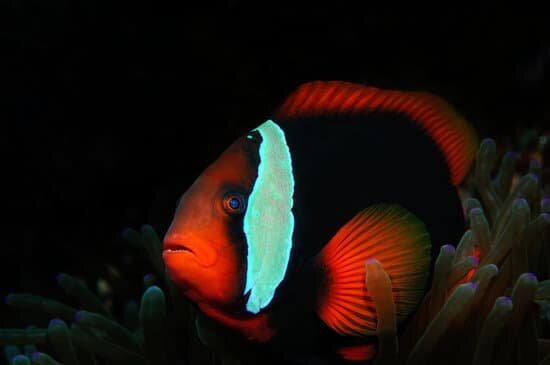
Tomato Clownfish prefer to live in saltwater. Amphiprion frenatus is its scientific name. Tomato Clownfish have an attractive and hardy appearance. Its body is orange with three white stripes lined up in a row. As they grow older, two stripes disappear, and you can see only one stripes. They have quite aggressive behavior. They can live up to 6-8 years. But if you provide nutritional food such as frozen brine shrimp, pellets, and frozen Mysis shrimp, they can live for more years.
Growth Rate: Attain 1 inch every year
Max height: 5 inches
Light Demands: Any (don’t require special light)
Difficulty: Extremely easy to care
#2 Saddleback Clownfish
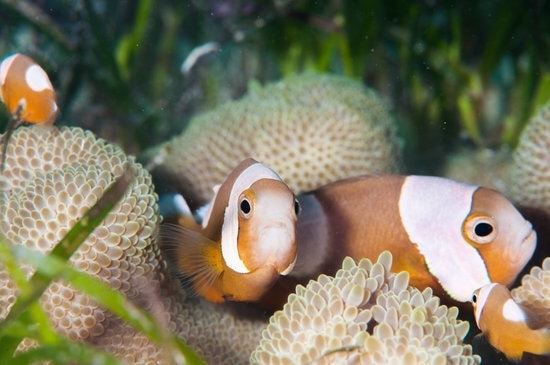
Saddleback Clownfish is one of the largest among their species. Its scientific name is Amphiprion polymnus. Saddleback clownfish have uncountable names. Some include Yellow-Finned Anemone-fish, Saddle Back Clown, Saddleback Anemonefish, and Panda Clownfish.
It has a beautiful appearance with black color and some white stripes. However, if you compare Saddleback clownfish with other clownfish, they aren’t much aggressive.
Growth Rate: Depending on the environment
Max Height: 4.5-5 inches
Light Demands: Any
Difficulty: Very easy to care
#3 Maroon Clownfish
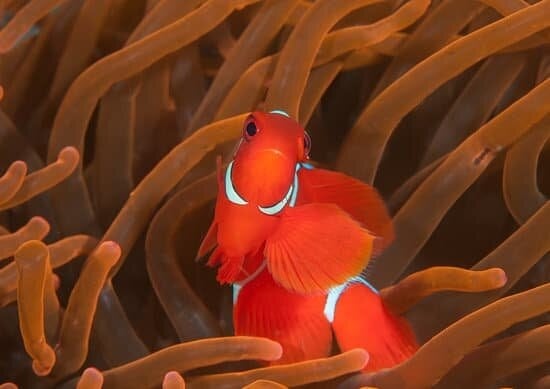
Its scientific name is Amphiprion frenatus. They are commonly known as Lightning Maroon Clownfish due to the three golden stripes present on its body. They are extremely aggressive that they don’t even leave their species and bully them constantly. It is advised not to keep small fish with Maroon Clownfish in the same tank. They can live up to 5-7 years.
Growth Rate: 1 inch per year (similar as Tomato Clownfish)
Max height: 5 inches
Light Demands: Any coral light
Difficulty: Easy care level
#4 Three-banded Clownfish
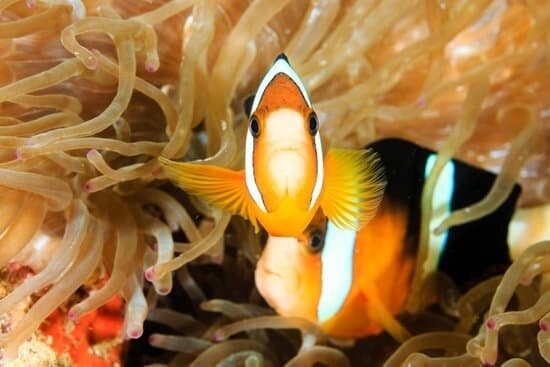
Amphiprion tricinctus is the scientific name of Three-banded Clownfish. You would find them in many colors, but orange is quite common. They have three stripes on their body of different widths. They have semi-aggressive nature. Therefore, it becomes quite difficult to keep them in a group. They can be kept in freshwater as well as in saltwater. Generally, female Three-banded Clownfish has a bigger size than a male.
Growth Rate: 0.5-1 inch per year
Max height: 5 inches
Light Demands: No special requirements
Difficulty: Manageable
#5 Mauritian Clownfish
They are found in the Pacific Ocean. Amphiprion chrysogaster is its scientific name. Mauritian Clownfish has an extremely dark black body with three stripes of white color. They are omnivores who prefer to eat plants and meat. Their lifespan ranges from three to five years.
Growth Rate: Attain 0.5 inches within every six months
Max Height: 3.5-4 inches
Light Demands: Any light until any anemone isn’t in the tank
Difficulty: Quite easy to care
#6 Oman Clownfish
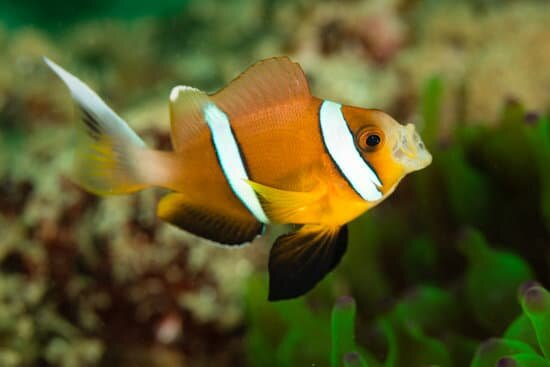
Oman Clownfish are popularly known as Amphiprion omanensis. They are found in the Indian ocean. As they become older, their aggression level also increases. Therefore, it is advised to keep them with fish of similar nature. They generally live for not more than 13 years.
Growth Rate: Not so fast
Max height: 6 inches
Light Demands: Any (but would require bright light if kept with anemone)
Difficulty: Quite manageable
#7 Clarkii Clownfish
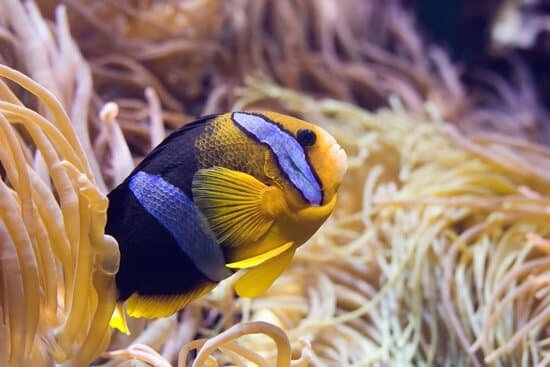
Their scientific name is Amphiprion clarkii. Clarkii Clownfish has a very attractive and nice appearance that you can’t take off your eyes from them. They love swimming, hence, require enough space to swim freely. They normally have a lifespan of 14 years.
Growth Rate: 0.5-1 inch every year
Max Height: 5-5.5 inches
Light Demands: As your wish
Difficulty: Extremely easy
#8 True Percula Clownfish
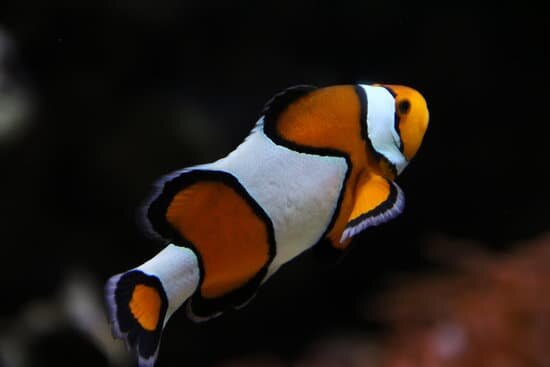
They are the smallest among all the species of Clownfish. Their scientific name is Amphiprion percula. True Percula Clownfish have a variety of names. Some include Eastern Clown Anemonefish, Percula Clownfish, Orange Anemonefish, and Orange Clownfish. They have an orange color body with three white stripes of different sizes. Their lifespan ranges from 20 to 30 years.
Growth Rate: Attain a size of 2.5 inches within 7-8 months
Max height: 3 inches
Light Demands: No strict requirement of light
Difficulty: Very easy
#9 Frostbite Clownfish
Amphiprion ocellaris is the scientific name of Frostbite Clownfish. They prefer to live in saltwater. The whole body of these fish has a white color with some orange dots on it. The dots attain darker color as the fish grows. They have a very calm, non-aggressive, and peaceful nature.
Growth Rate: Attain 0.5-1 inch per year
Max height: 3 inches
Light Demands: Any until the tank doesn’t have any anemone
Difficulty: Quite simple and easy
#10 Midnight Clownfish
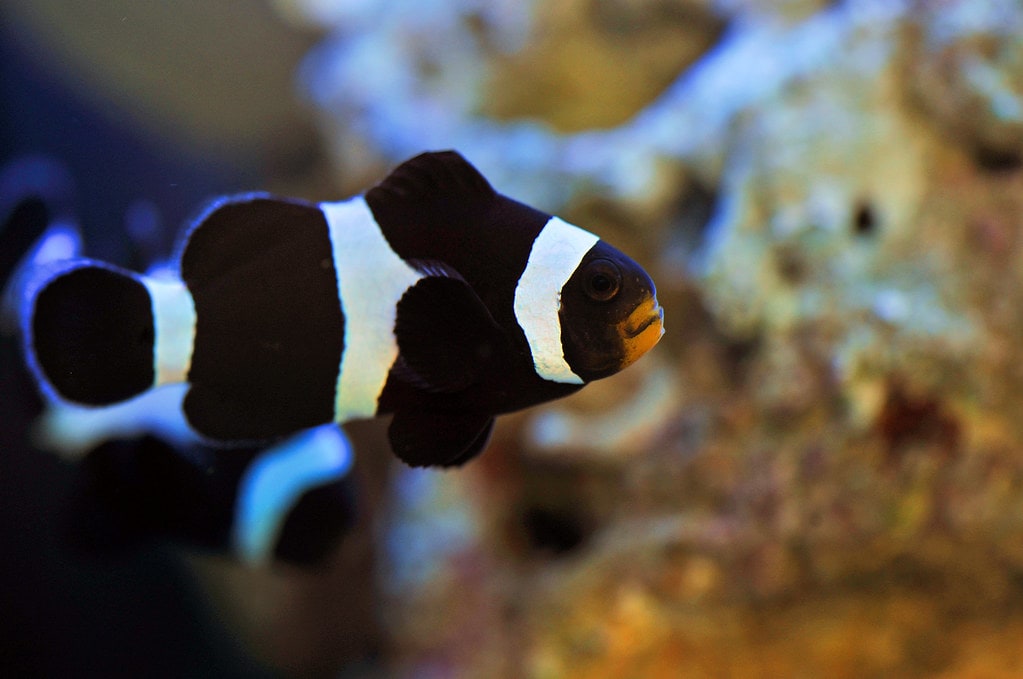
Midnight Clownfish are popularly known as Amphiprion ocellaris (scientific name). These fish are counted among the rarest clownfish. At the very initial stage, their body has some brown color. As they grow older, the brown color turns to dark black. These fish don’t have any stripes on their body.
Growth Rate: Grow 1 inch every year
Max height: 3 inches
Light Demands: No special demands for lighting
Difficulty: Not difficult to care for
#11 Longfin Mocha Clownfish
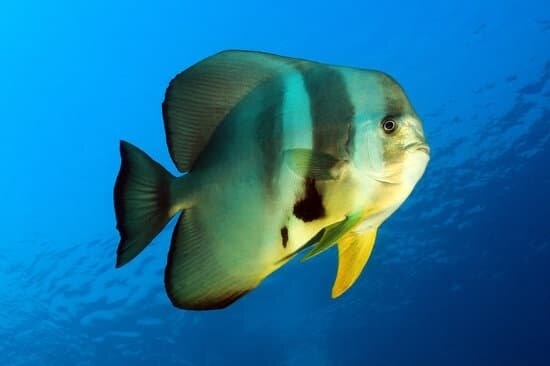
They are commonly known as “Amphiprion ocellaris” (scientific name). Longfin Mocha Clownfish has an orange body with white stripes and black shades on its fins. They have such long fins that provide them with a unique look. They are quite hardy and peaceful.
Growth Rate: 0.5-1 inches per year
Max height: 4 inches
Light Demands: No strict requirement of light
Difficulty: Relatively easy to care for
#12 Phantom Clownfish
Amphiprion ocellatus is the scientific name of Phantom Clownfish. They have a black and white appearance. They are primarily found in saltwater. Their peaceful and non-aggressive behavior makes them a great choice for your tank. A beginner can easily handle them.
Growth Rate: Takes around four years to reach its maximum size
Max height: 4 inches
Light Demands: Any (don’t require special light)
Difficulty: Manageable
#13 Cinnamon Clownfish
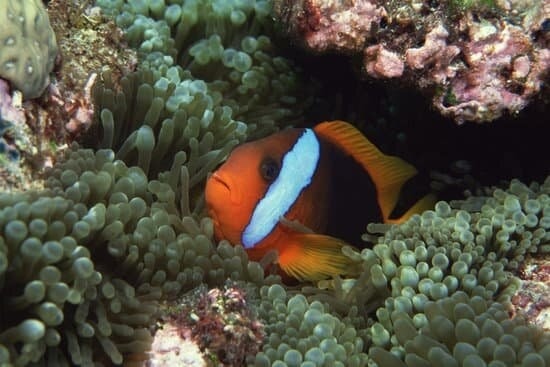
Cinnamon Clownfish are popularly known by the name “Amphiprion melanopus.” These fish have an extremely dark red body with light orange fins. In addition, Cinnamon Clownfish has a vertical white stripe near both eyes. They are hardy and have semi-aggressive nature. Generally, they live a life of 17 years.
Growth Rate: 2.5 cm or more per year
Max Height: 4.5-4.7 inches
Light Demands: Any
Difficulty: Manageable
#14 Red Sea Clownfish
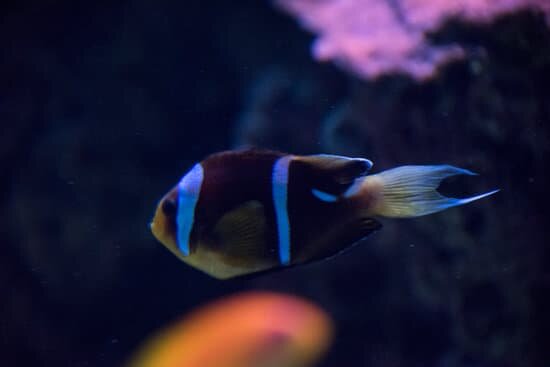
Red Sea Clownfish are commonly known by the name “Amphiprion bicinctus”. These fish have such big eyes that they have gained popularity. In addition, red Sea Clownfish has non-aggressive nature. Therefore, a beginner can also keep this fish easily. If provided a good environment and fed nutritional food, these fish can live for around 20 years.
Growth Rate: Takes around 2-3 years to attain its maximum length
Max height: 5.5 inches
Light Demands: Doesn’t require any special light
Difficulty: Manageable (easy care)
#15 Pink Skunk Clownfish
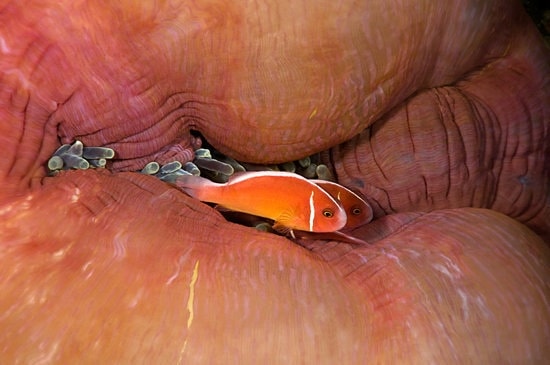
Amphiprion perideraion is the scientific name of Pink Skunk Clownfish. Their color is relatively different from other Clownfish. You would notice a white stripe on their pink to the peach-shaded body. Pink Skunk is quite calm and peaceful. However, any abrupt change in water conditions can make your fish distressed. It is because they are very sensitive. They can’t live for more than 21 years.
Growth Rate: Grow 2.5 cm every year
Max Height: 2-3 inches
Light Demands: Any (but would require bright light if kept with anemone)
Difficulty: Quite difficult to care for
What Are The Rarest Clownfish?
McCullochi clownfish is the rarest clownfish, and its scientific name is Amphiprion mccullochi. They are found in Norfolk Island and Lord Howe Island. Their body has dark brown color with a white tail and one white stripe beside both the eyes. They have a very aggressive nature. Therefore, it is advised to keep them with fish of similar nature.
What Is The Most Common Type Of Clownfish?
Ocellaris clownfish is considered to be the most common type of clownfish. They are popularly known by the name “false percula clownfish”. Their body has orange color with three stripes of white color. They have quite a calm and peaceful nature. Therefore, even a beginner can care for Ocellaris Clownfish easily. They can live for more than 15 years.
Frequently Asked Questions
What Is The Biggest Clownfish?
Gold Stripe Maroon Clownfish has attained the tag of the biggest clownfish. These fish, commonly known as spine-cheeked anemone fish, have a maroon color body with three stripes of golden color. Their maximum size is 6 inches, but female Maroon Clownfish can even attain a length of around 7 inches.
What Is The Smallest Clownfish?
When it comes to the smallest clownfish, True Percula Clownfish is the only one that can’t attain a length of not more than 3 inches. Their body has some orange color with three white stripes of different sizes. Their lifespan ranges from 20 to 30 years.
How Many Times Do You Feed A Clownfish A Day?
Since there are around 30 species of Clownfish, therefore, it would depend on the type and size of the spices that how many times you would require to feed your clownfish. But it is recommended to feed your clownfish with nutritional food twice a day with a gap of around 8-9 hours. You should keep in mind that your clownfish don’t overeat. Therefore, it is advised not to let your fish eat for more than 1-2 minutes at a time.
Wrapping Up
Clownfish are quite manageable to care for. Therefore, even a beginner can also think of keeping these elegant and attractive clownfish in the fish tank. In the above article, we discussed a complete detail about clownfish and also some types of clownfish. We hope you found the above article useful, and it will help you choose the best clownfish for your fish tank.
